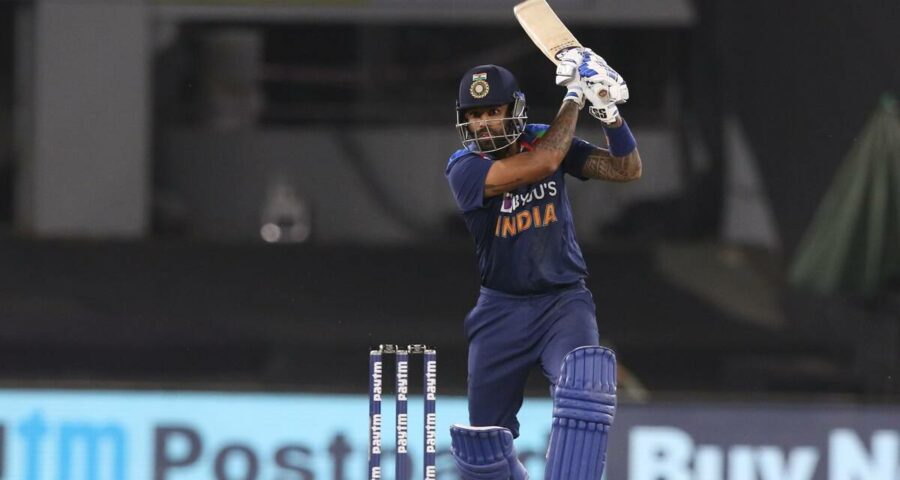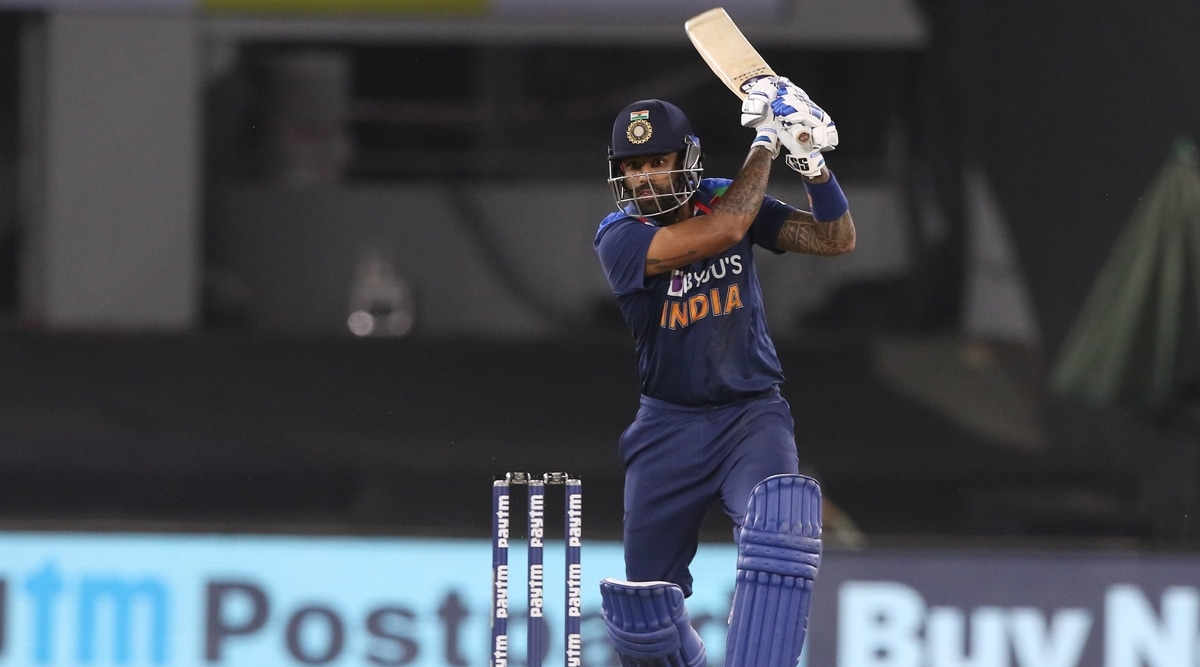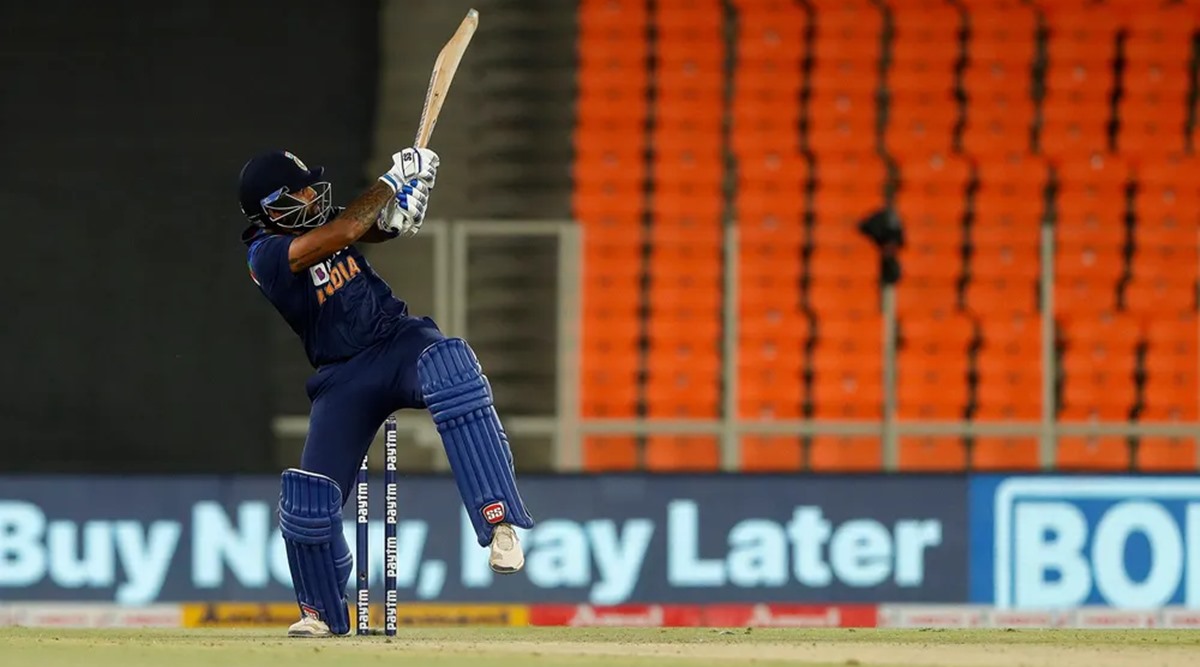Suryakumar Yadav combined brilliance and audacity in his strokeplay to stamp his class during his international debut.
When Suryakumar Yadav strode onto bat for the first time in an international game, gently winding his arms and hawkishly surveying the field, Jofra Archer glared menacingly from the top of his run-up, his fingers firmly wrapped over the seam of the ball and his body arching like a prize-horse about to be unbolted. He thundered into his stride, gathering steam before, with a sudden whirl of limbs and frightening arm-speed and thrust of the shoulders, unleashed a thunderbolt down to the centre of the pitch.
Yadav, facing his very first ball of international cricket, ending what seemed like an eternity of longing, seemed utterly frozen. Only that, as the ball leapt off from the centre of the pitch, he made a firm sideways stride to cover the line of the ball, then threw his front pad in mid-air like a gymnast and swatted it over the fine-leg ropes. A more brutally brilliant stroke he could not have executed off the very first ball of his international career. There was both brilliance and beauty.
The beauty of the stroke was that he made it look all too natural. There was no hint of premeditation or a release of suppressed nervous energy or a sense of over-keenness. There was calm, a sense of belonging and just plain, spontaneous joy. His eyes kept tracing the ball until it settled into an empty seat in the stands. At that precise moment, he would have just whistled in the air and whispered: “Maza aatha hain, yeh shot khelne mein (I really enjoy playing this shot).”
This is Yadav’s stock reply to why he loves certain strokes. Like the pull that he just pulled out, or the sweep that swept out Adil Rashid. Of the six boundaries and three sixes that he stroked in the evening, each was a spectacle worthy of standalone value and description. Forget not the inside-out six over cover off Adil Rashid’s wrong’un, against the turn and the ball drifting in a bit, or the slap-sweep off Sam Curran, the ball before he perished. He wears audacity on his sleeve, but without arrogance.
Archer should not say he was not forewarned. A few months ago, in an IPL encounter, he had reverse-scooped the quick a ball after he was struck on the helmet. The way he described that exchange in a recent interview to The Indian Express, throws light on his batsmanship as well as psyche: “When I got hit on the helmet, I said one boundary or six toh marna he padega. Meine khaya hai toh tumko bhi khana padega. (I said to myself that I have to hit a four or a six. I was hit, now I will hit you). I went to Hardik and said yeh wala stroke banta hai kya? (will this stroke work?). He said, it is completely your call, and whatever you think just back it. I told myself that if this ball is pitched here, I will go behind. I wanted to do something different.” And he did unfurl one of the shots of the tournament.
Again, he stressed at the end of the answer: “Maza aaya tha. (I enjoyed it)” As much as maza, it betrayed a streak of combativeness that lurks beneath his usually calm exterior. If not for this virtue, he could have burned his India dreams long ago. He probed, persisted and improved, thus realising the dream that he had nursed all his life.
There are other things cricketing that fills him with joy too. Like facing genuine quicks in the nets. “When I was in KKR, we had Umesh (Yadav) and Nathan Coulter-Nile. Then, at Mumbai Indians, we have Jasprit Bumrah, the world’s best fast bowler, then Lasith Malinga and Trent Boult. I don’t miss an opportunity to face them in the nets and I really look forward to this challenge every year. I used to relish playing them in the nets,” he explained. He could be a classic case study of IPL developing the all-round game of a player.
Or sweeping the daylights out of spinners. “Where I played cricket, there were a lot of spinning tracks and good spinners, so I had to learn playing the sweep. Then the stroke became a habit,” he said.
When he says how much he enjoys playing a particular shot, you could feel his joy and enthusiasm, like he’s still a wet-behind-the-ears teenager and not a vastly experienced 30-year-old veteran. “It’s this love for the game that had kept me going all through my life, in both my good days and bad ones,” he said.
He would have derived a lot of joy in how he maintained a healthy strike rate even after the power-play overs, an aspect of the game Mumbai Indians coach Mahela Jayawardene had counselled him to improve. In fact, he was better post-powerplay. In the period of field-restrictions, he scored 16 off 11; in the non-powerplay overs, he blazed 41 off 20 balls. “He said only one thing, whenever you’re batting after the powerplay, just try and hit a lot of gaps, take twos, do run hard between wickets and there won’t be any pressure and the strike rate also will be amazing,” he recollected the conversation.
As frequently as boundaries were pouring from his blade, he didn’t forget the sneaky singles and breezy twos. So much so that he played out just a couple of dot balls after the powerplay overs. His improved fitness — he knocked off 12 kgs in an intense three months of diet and training during lockdown — ensured that he didn’t tire towards the end. There is both style and steel to his game.
In a short time, he also showed dexterity in dealing with situational demands, like eschewing risks after the successive departure of Virat Kohli and KL Rahul. He held the innings together with the assertiveness of a seen-it-all expert hand, and not at any point did he betray that he was someone batting for the first time in international cricket. It’s too preposterous to suggest he is the key to unlocking the middle-over riddle, but evident was a sense of belonging, and a sense of ease and calm that portends a longer international sojourn. And that he gets a lot of maza in every little thing that he does on a cricketing field.
Source: Read Full Article



